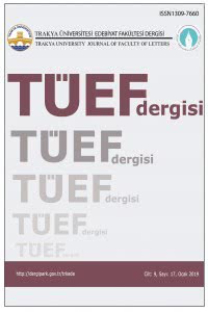İKİZ VENÜSLER MİTİ ÇERÇEVESİNDE GIULIA BIGOLINA’NIN URANIA, THE STORY OF A YOUNG WOMAN’S LOVE ADLI ESERİ
İtalya’da kadın sorunu üzerine yazan öncü bir isim olan Giulia Bigolina, yakın zamanda
Anahtar Kelimeler:
Bigolina, Venüs, protofeminizm, kadın sorunu, resim sanatı
GIULIA BIGOLINA’S URANIA, THE STORY OF A YOUNG WOMAN’S LOVE WITHIN THE FRAMEWORK OF THE MYTH OF TWIN VENUSES
The pioneering figure to write on the woman question in Italy, Giulia Bigolina is the recently unearthed author of a prose romance Urania, the Story of a Young Woman’s Love (1552). She is a pivotal author regarding the protofeminist literature in the early modern Italy. In the proem to the work, Bigolina depicts a scene in which her authorial persona is visited by a homunculus to urge her to produce a literary work contrary to her initial decision to passively pose for a painting in front of an artist. Likewise, the romance section focuses on the protagonist Urania who turns out to be a virtuous intellectual dealing with literature. Contrariwise, the Duchess of Calabria, who serves as a foil to Urania, has herself painted semi-nude. It is highly possible that Bigolina identifies Urania and the Duchess with the goddess Venus because the famous artist Titian employs Venus in many of his paintings such as “Venus of Urbino” and “Sacred and Profane Love” and it is known that they were contemporaries, exchanged letters, and Bigolina was familiar with his paintings. The dual representation of Aphrodite Urania and Aphrodite Pandemos refers to her double nature in the classical mythology and in the texts such as Plato’s Symposium. Within this framework, this study argues that Bigolina employs the myth of twin Venuses as a medium to construct the protofeminist concern of her work through her identification of Urania and the Duchess with them in that their juxtaposing positioning enables her to criticise objectification of women then-current in the art of painting, to encourage them to prioritise intellectual cultivation over physical beauty and to be producers of literature.
Keywords:
Bigolina, Venus, protofeminism, woman question, art of painting,
___
- Bigolina, Giulia, Urania: A Romance, Translated by Valeria Finucci, Chicago, 2005, The University of Chicago Press.
- Finucci, Valeria, “Giulia Bigolina and Italian Prose Fiction in the Renaissance,” Urania: A Romance, by Giulia Bigolina, edited and translated by Valeria Finucci, Chicago, 2005, The University of Chicago Press, p. 1-35.
- Firenzuola, Agnolo. On the Beauty of Women, Translated and Edited by Konrad Eisenbichler and Jacqueline Murray, Philadelphia, 1992, The University of Pennsylvania Press.
- Hesiod, Theogony. https://msu.edu/~tyrrell/theogony02.htm - accessed: 01.04.2019
- Nissen, Christopher, Kissing the Wild Woman: Art, Beauty, and the Reformation ofthe Italian Prose Romance in Giulia Bigolina’s Urania, Toronto, 2011, University of Toronto Press.
- Morford, Mark P. O. and Robert J. Lenardon, Classical Mythology, New York, 1985, Longman.
- Plato, Complete Works, edited by John M. Cooper, Indianapolis, 1997, Hackett Press.
- Simons, Patricia, “Portraiture, Portrayal, and Idealization: Ambiguous Individualism in Representations of Renaissance Women,” Languages and Images of Renaissance Italy, edited by Alison Brown, Oxford, 1995, Clarendon, p. 263-311.
- Yavneh, Naomi, “Review.” Renaissance Quarterly, 56. 4, 2003, p. 1172-1174.
- ISSN: 1309-7660
- Yayın Aralığı: Yılda 2 Sayı
- Başlangıç: 2011
- Yayıncı: -
Sayıdaki Diğer Makaleler
CHINUA ACHEBE’NİN PARÇALANMA (THINGS FALL APART) ADLI ESERİNDE KÜLTÜREL KİMLİĞİN BOZULMASI
Şule OKUROĞLU ÖZÜN, Nagihan BAŞKALE
Fast Forwarding with Audiovisual Translation
TÜRKÇE VE BULGARCADA ZAMAN/GÖRÜNÜŞ
The Shakespeare Circle: An Alternative Biography
FAKRU’D-DEM TERİMİ VE KLASİK TÜRKÇE TIP METİNLERİNDEKİ EŞ ANLAMLILARI
CARLO GOLDONI VE LOKANTACI KADIN ADLI YAPITINDA TOPLUMSAL ÖGELER
